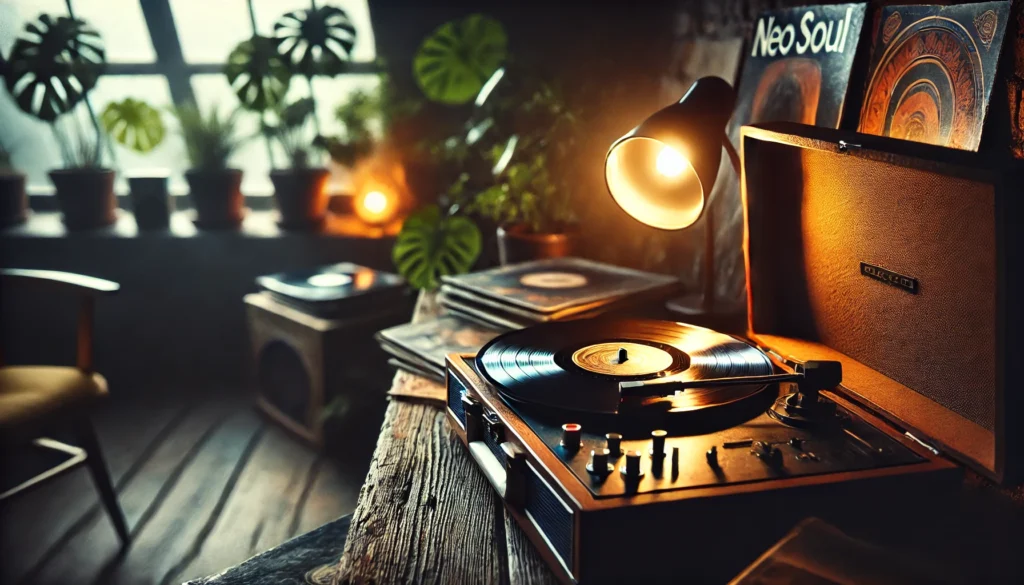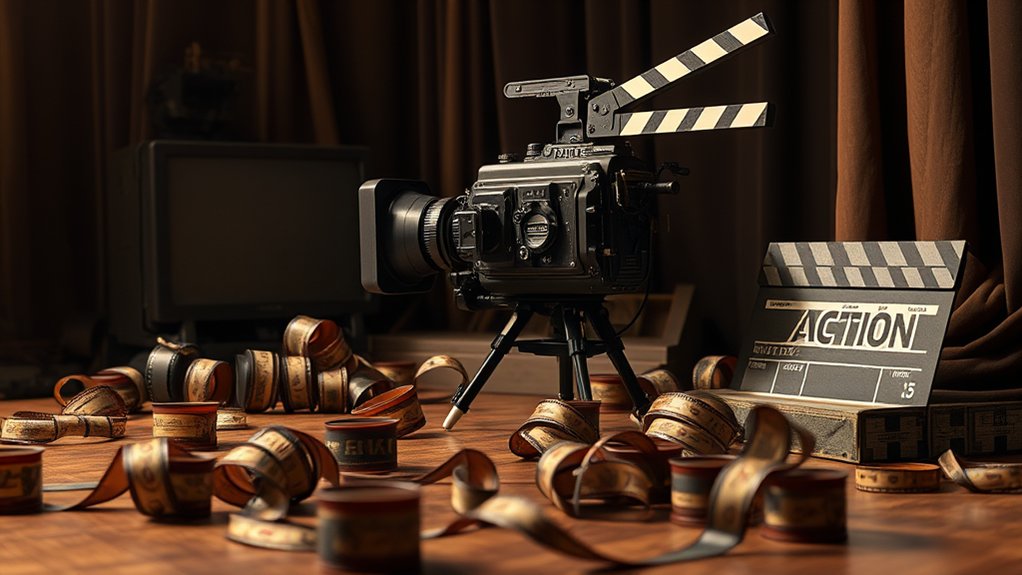
Key Takeaways
- Neo Soul emerged in the 1990s, blending traditional soul with hip-hop, jazz, and electronic influences to create a unique sound.
- Pioneering artists like Erykah Badu and D’Angelo utilized live instrumentation and introspective lyrics to redefine R&B boundaries.
- The genre emphasizes authenticity and emotional depth, often exploring themes of love, identity, and social consciousness.
- Contemporary artists such as H.E.R. and SZA continue to revive Neo Soul by merging traditional elements with modern sounds and themes.
The Journey of Neo Soul: A Musical Adventure
Neo soul is a super cool music genre that started in the 1990s.
It’s all about mixing different styles like soul, hip-hop, and jazz together.
Artists like Erykah Badu and D’Angelo were the first to bring this vibe to life.
Now, we have modern stars like H.E.R. and SZA, who are shaking things up with their own twists.
Let’s dive into the story of neo soul and see how it has changed and what it might become!
Roots of Neo Soul
Back in the 1990s, music was starting to change a lot.
Neo soul popped up as a fresh sound that combined the smoothness of soul with the beats of hip-hop and the improvisation of jazz.
Erykah Badu, with her dreamy voice and funky style, became a major player in this new genre.
D’Angelo followed closely, bringing sexy vibes and deep lyrics that made everyone feel something special.
These artists helped create a community where music was not just about the beats but also about feelings and stories.
New Artists Rising
Fast forward to today, and neo soul is experiencing a major revival!
Young artists like H.E.R. and SZA are taking the genre to new heights.
They mix old-school sounds with modern twists, creating something totally fresh.
H.E.R.’s guitar skills and SZA’s unique voice have captured the hearts of many fans.
It’s exciting to see how they are shaping the future of neo soul!
What Does It All Mean?
As we look at the journey of neo soul, we can see how music reflects what’s happening in society.
The themes in neo soul often touch on love, struggle, and self-discovery.
These messages resonate with listeners, making them feel connected to the artists.
The genre has grown and changed, just like the world around it.
Who knows what the future holds for neo soul?
Let’s keep our ears open for more amazing sounds and stories that are yet to come!
Origins of Neo Soul
Neo soul emerged in the 1990s as a genre that blended the rich traditions of soul music with contemporary influences, reimagining the sound for a new generation.
This innovative movement arose as artists sought to move beyond the boundaries of traditional R&B and soul, incorporating elements from hip-hop, jazz, and electronic music.
The genre’s origins can be traced to the growing desire for authenticity and emotional depth in music, reflecting the experiences and struggles of a diverse audience.
The early pioneers of neo soul utilized live instrumentation, intricate arrangements, and introspective lyrics to create a distinct sound that resonated with listeners.
This approach not only honored the legacy of classic soul artists but also introduced new textures and narratives, making it relevant in an ever-evolving musical landscape.
The rise of independent record labels and digital platforms further facilitated the genre’s expansion, allowing artists to reach wider audiences without conforming to mainstream expectations.
As neo soul continued to evolve, it fostered a sense of community among artists and listeners, emphasizing self-expression and cultural identity.
This foundation set the stage for future innovations and the enduring appeal of the genre.
Key Artists and Influences
Key artists such as Erykah Badu, D’Angelo, and Jill Scott played an essential role in shaping the sound and direction of the neo soul movement, each bringing their unique influences and artistry to the genre.
Badu’s lyrical introspection and eclectic style have made her a cornerstone of neo soul, blending elements of R&B, jazz, and hip-hop.
D’Angelo’s groundbreaking debut, ‘Brown Sugar,’ introduced a lush sound palette that incorporated funk and soul, setting the standard for subsequent artists.
Jill Scott’s powerful vocals and poetic lyricism added depth and emotional resonance, further enriching the movement.
These artists not only defined neo soul but were also influenced by a range of musical traditions, including:
- Classic Soul: Drawing inspiration from legends like Marvin Gaye and Aretha Franklin.
- Hip-Hop: Integrating the rhythmic and lyrical complexity of rap into their work.
As the genre evolved, these key figures remained pivotal in fostering a creative environment that encouraged experimentation and authenticity.
Their contributions laid the foundation for a vibrant neo soul revival, inspiring new artists to explore this rich musical landscape.
Musical Characteristics and Innovations
The evolution of neo soul is marked by distinctive musical characteristics and innovative approaches that blend various genres, creating a sound that is both richly textured and deeply expressive.
Central to neo soul’s identity is its fusion of traditional soul, jazz, hip-hop, and R&B, which provides a unique sonic landscape. Artists often employ complex chord progressions and lush instrumentation, incorporating live instruments alongside electronic elements to enhance emotional depth.
Vocally, neo soul emphasizes improvisation and personal expression, allowing artists to convey vulnerability and authenticity. The use of syncopated rhythms and off-beat patterns reflects the genre’s jazz influences, while lyrical content often explores themes of love, identity, and social consciousness.
Innovations in production techniques have also played a significant role in shaping neo soul. The genre frequently features sampling, looping, and layering, which create intricate soundscapes that invite listeners to engage on multiple levels.
Collaborations between artists and producers have further expanded the genre’s boundaries, introducing diverse sounds and styles. As a result, neo soul continues to evolve, embracing new influences while remaining rooted in its rich musical heritage.
Cultural Impact and Significance
How has neo soul shaped cultural narratives and influenced contemporary music trends? Neo soul emerged in the late 1990s as a genre that not only celebrated Black musical heritage but also challenged societal norms, thereby crafting new cultural narratives.
By blending elements of R&B, jazz, hip-hop, and funk, neo soul artists have created a sound that resonates with diverse audiences while addressing themes of love, identity, and social justice.
The genre has considerably impacted contemporary music trends in several ways:
- Authenticity in Expression: Neo soul emphasizes genuine storytelling, encouraging artists across genres to connect with their audiences on a personal level.
- Fusion of Styles: The blending of various musical influences has inspired a new wave of artists to experiment with genre boundaries, leading to innovative sounds and collaborations.
Contemporary Revival and Future Trends
A resurgence of interest in neo soul has emerged in recent years, marked by a new generation of artists who draw inspiration from its rich musical heritage while pushing the boundaries of the genre.
Contemporary musicians such as H.E.R., SZA, and Anderson .Paak embody this revival, seamlessly blending traditional elements of soul, R&B, and hip-hop to create innovative soundscapes. Their work not only honors the past but also reflects modern themes, capturing the complexities of contemporary life.
This revival is further propelled by the accessibility of digital platforms, allowing artists to reach wider audiences and cultivate dedicated fanbases. The fusion of neo soul with genres like electronic and alternative music has opened avenues for experimentation, inviting collaborations that enrich the genre’s texture.
As we look to the future, the evolution of neo soul appears promising. Emerging artists continue to explore diverse influences while maintaining the emotional depth that characterizes the genre.
With increased visibility and recognition, neo soul is positioned to thrive, potentially influencing mainstream music trends and inspiring yet another generation of musicians drawn to its soulful essence.
Conclusion
Conclusion: The Enduring Legacy of Neo Soul
The evolution of Neo Soul demonstrates the genre’s rich history and ongoing relevance in contemporary music. From its 1990s origins with pioneering artists to the current revival led by new voices, neo soul continues to blend traditional elements with modern influences.
The emphasis on authenticity and emotional depth allows for exploration of profound themes, ensuring that neo soul remains a significant cultural force. Future trends suggest continued innovation, solidifying its place within the broader musical landscape.










